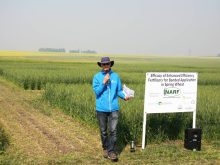The potato is the third most important food crop globally. Millions of farmers and billions of people depend on it. Unfortunately, diseases also dine on the potato, eating into yields.
The main enemy is late blight, an aggressive parasite that can destroy a potato crop in a matter of weeks. Late blight has become increasingly common due to global warming. It’s a serious threat to existing potato varieties, costing farmers worldwide about US$10 billion every year.
A disease-free potato would be a boon to growers and humanity. That disease-free potato recently became a reality.
The new disease-proof potato is called CIP-Matilde. In creating the new variety, Peruvian potato growers and breeders collaborated with the International Potato Center and Crop Trust through its Crop Wild Relatives Project. The new variety has resistance genes from wild potatoes transferred through a conventional breeding method called pre-breeding.
CIP-Matilde made its public debut at the 42nd World Food Day, Oct. 14 in Bonn, Germany, according to a news release from Crop Trust.

Crop Wild co-ordinator Benjamin Kilian said adapting agriculture to the threats posed by pathogens, pests and weeds, we can help ensure greater food security. “Pathogens, pests and weeds cause major crop losses, particularly in the developing world.”
The new potato has been in development since 2010, according to Rolando Papuico, a potato farmer from Huancayo province where CIP-Matilde was developed.
“Late blight can destroy everything. It can leave you without enough to eat, to sell, not even enough to use for seed,” Papuico said. “CIP-Matilde produces a lot, the potatoes taste good boiled, mashed, fried, in soup. And late blight doesn’t affect it the way it does other varieties. Now I don’t have to invest so much in agrochemicals.”

Pre-breeding is a process of crossing modern varieties with wild potato species that have natural resistance to diseases. Pre-breeding requires the scientist to maintain all positive traits of the domestic potato while optimizing disease resistance and eliminating unwanted wild traits, such as long runners and irregular tubers.
This conventional, time-consuming process requires three or four back-cross generations, each of which takes four or five years. It’s normal for the process to take 12 to 20 years to create new parent lines suitable for commercial breeding.
















